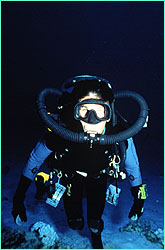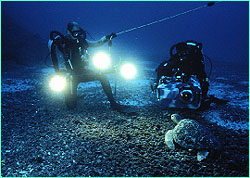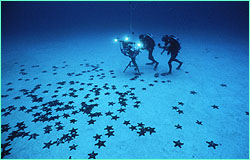 |
 |
 |
Part 2 (back to Part 1) NOVA: What are the challenges of using an IMAX camera underwater? Howard Hall: Just about every facet of production is more complicated. Whether it's video or 16 mm, a television camera in an underwater housing might weigh 45 pounds, and it will hold anywhere from 12 to 60 minutes of film or videotape. The IMAX system weighs 250 pounds once it's in the underwater housing, and it only runs for three minutes. Which means you have to be extremely careful about when you push the button to roll film. You have a limited selection of lenses you can use in IMAX; we don't use zoom lenses, for instance. You need a larger crew. And you need different equipment and lots of it.
Howard Hall: To make a good natural history IMAX film, I needed a much broader selection of lenses and capabilities than were available with the equipment IMAX already had. So we modified an IMAX camera and built an underwater housing to protect it. The housing alone took us a couple of years to construct. We also built special lighting systems, light meters, and a tripod, all for use underwater. And we started using underwater communications so that we could talk to the surface and talk to each other while diving.
Howard Hall: In giant format, everything takes longer—setting up a shot, getting the camera to a position to mount it, mounting it, and getting it steady so that currents and surges aren't moving it around. Standard scuba equipment gives you limited time. At a depth of 100 feet, which we're working at quite a bit, your air only lasts about 40 minutes. That's just not long enough. To do the IMAX film, we've almost exclusively used rebreathers. These are fully closed-circuit devices that recirculate all the gas you're breathing, taking out the carbon dioxide and replenishing the gas with oxygen. It creates no bubbles, it makes no sound. With the unit we're using, which is a Navy Mark 15 system, we can stay down as long as 12 hours on a single dive.
Howard Hall: Unlike the rebreathers, the camera makes a helluva lot of noise, and most of the animals take off like bats. That's especially true of hammerheads. Plus, the camera takes almost five seconds to rev up to speed and begin capturing an image. In order to get a good shot , I have to anticipate the animals coming way ahead of time. So I'll see, for example, a school of sharks maybe 150 feet away coming in my direction. I'll turn the camera on, hoping to get them coming into the scene. But typically by the time the camera is running to speed, the noise has already frightened the sharks away. We are getting good shots of hammerheads, it's just taking a lot longer than I thought.
Howard Hall: We're shooting about a 20-to-1 ratio. That's 20 feet of film for every foot that will actually end up in the film. We'll shoot almost 300 rolls of film during this production, which means that we have to make at least 300 dives. Since each dive typically lasts at least an hour and a half, to get those 300 rolls of film we'll have to spend 450 hours underwater. Continue: What's the island itself like? Is it challenging to shoot there? Cocos Island | Sharkmasters | World of Sharks | Dispatches E-mail | Resources | Site Map | Sharks Home Editor's Picks | Previous Sites | Join Us/E-mail | TV/Web Schedule | About NOVA Watch NOVAs online | Teachers | Site Map | Shop | Search | To Print PBS Online | NOVA Online | WGBH © | Updated June 2002 |
 Howard Hall and Lance Milbrand with IMAX camera.
Howard Hall and Lance Milbrand with IMAX camera.
 Howard Hall
(with IMAX camera) and Bob Cranston on the seafloor.
Howard Hall
(with IMAX camera) and Bob Cranston on the seafloor.
 Howard
Hall using bubbleless rebreather.
Howard
Hall using bubbleless rebreather.
 Shooting a green turtle at Cocos.
Shooting a green turtle at Cocos.
 Time-lapse filming of starfish.
Time-lapse filming of starfish.